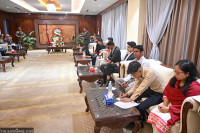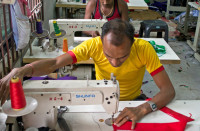Opinion
Just victims?
Migration abroad for work has become an important issue in Nepal over the past two decades.
Migration abroad for work has become an important issue in Nepal over the past two decades. Remittance contributes to the country’s GDP, while out-migration offsets labour force pressure in a domestic market that is incapable of absorbing the annual ingress of youth—numbering around 350,000. Returnees are thought to contribute to the country’s development through entrepreneurship by making use of newly acquired skills. However, migration for work is understood as having untoward social consequences resulting from the segregation of families and the loss of youth force required to build the nation. More contentious is the issue of women out migrants. They are perceived in a negative light in our society through the narratives of exploitation and victimhood. This article aims at presenting a new perspective against the dominant trend of viewing Nepali women out-migrants as victims.
History of migration
Nepal’s youth have been migrating out for work for more than 200 years, with people being employed as soldiers for Ranjit Singh in Lahore even before Nepalis were incorporated in the British army following the Sugauli treaty in 1815. India is one of the major destinations for Nepali youth thanks to the open border and ease of transportation. For a long period, Nepali women had been migrating to India for work and also joined their husbands there. Women started to migrate to Gulf countries for work independently with the decline of the carpet industry in Nepal in the 90s. Migration in men far outweighs female migration. Reports estimate that women out-migrants comprise 10 to 12 percent of the total out-migrant population.
Nepali women migrants are categorised as skilled and semi-skilled or unskilled. Skilled migrant women workers are usually nurses who migrate to English speaking countries like UK, Canada and USA. However, as suggested by a UK based researcher, highly skilled Nepali nurses are “deskilled” in the developed world since they cannot practice their skills because they are confined to low level work. Another category of skilled women out-migrants are beauticians. Many young trainees as well as practicing beauticians dream of migrating to countries like UK, UAE, Portugal and Israel, where the pay is higher than in Nepal. Semi/unskilled women migrate to Gulf countries like Saudi Arabia, Kuwait and United Arab Emirates, among others. Most of these women work as house maids, though some are also employed as sales girls or office helpers.
Dominant narratives
The case of females migrating out does not generate as much discussion as the case of male migration in our society. A rigid conventional gender norm of women belonging in the private sphere is gradually weakening; yet, the out-migration of women workers is looked upon with suspicion. Cases that generally fall under such suspicion are semi/unskilled women workers in the Middle East. For semi/unskilled female workers, it is generally thought that migrating to the Middle East is tantamount to being exploited economically, or being sexually abused. Media often come up with stories of women who were physically or sexually abused at the work place. However, the fact is that males also undergo untold suffering. Many male migrants lose their lives while at work. Yet, the suffering of women migrants make appealing stories in the media. Responding to such plights of women migrants, since 1997, the Nepal government has been adopting protectionist measures by reimposing several types of bans. For example, the government in 2012 had imposed an age bar stating that only women aged 30 and above could work as domestic workers in the Middle East. The logic was that a woman at 30 is mature enough to defend herself from exploitation. Such bans have not discouraged many women, as they choose informal methods of migration instead.
A new understanding
Out-migration of Nepali women is often understood from the economic perspective of push and pull factors alone. In a society like ours where family and citizenship laws were highly discriminatory until a few years ago, such an understanding is flawed. What propelled the women of Nepal to migrate to countries having a different language and culture to become breadwinners while their place was supposed to be within the threshold of their homes? A number of factors contributed in preparing Nepali women to become out migrants. One factor is the history of following their men to work abroad. Education also expanded women’s mental horizon. The most powerful factor of change is the Maoist insurgency, which shattered the image of Nepali womanhood. Women fighters and commanders within Maoist ranks redefined Nepali womanhood as not being passive and weak. The insurgency also compelled women to become heads of households. The sociological concept of agency better explains the phenomenon of women out-migration. Agency may simply be understood as the capacity of a person to act—where the elements from his/her past and present experiences are involved in unison and in one’s execution of an action. Agency is the capacity of individuals to act independently and to make their own free choices. Thus, it is important to understand Nepali women’s out-migration as the expression of their agency.
Women remit higher amounts, thanks to their saving habit. Their choice to migrate could also result in tragedy as is aired by media. However, this has not deterred them from exercising their agency. Nepali media does not portray success stories of out-migrants; how they have supported their family, or how returnees actively migrate again for better jobs. Or how the returnee domestic maids also have cherished memories of their host families. In the meanwhile, the social impact of women’s out-migration, mostly in the aspect of care, cannot be ignored. However, it
is important that women should be able to lead their life in the same way men do, by pursing their goals. The burden falls on the state and civil society: Instead of protectionist measures, remedies should be sought. Stake holders can create a safe environment for women migrant workers in destination countries. The state can develop a mechanism to replace their care work back home; males can be trained to replace women in household care. Another option is for the state to create enough opportunities back home such that Nepali women are happy to choose to work in their own country while earning higher pay. This way, they can realise their dreams of experiencing the outer world safely.
Oja is a PhD candidate at the Graduate School of Global Studies, Doshisha University, Japan




 17.12°C Kathmandu
17.12°C Kathmandu









